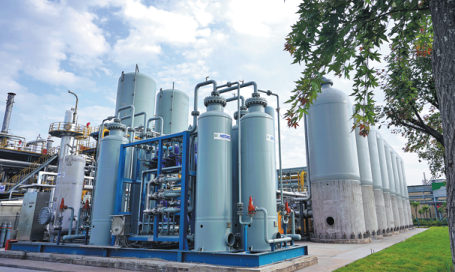Coal and energy industries safer and cleaner thanks to tech improvements
Updated: 2023-02-17

A hydrogen production facility established by Pengfei Group in the city of Xiaoyi. [Photo by Li Shu for China Daily]
With the application of digital, intelligent technologies, Shanxi's coal mining and energy industries are becoming cleaner, safer and more efficient.
The Shanxi Energy Administration reported that the province now has a total of 993 coal-mining shafts with smart, connected and automatic operation.
Changcun coal mine, a subsidiary of Lu'an Chemicals Group based in the city of Changzhi, has seen its shafts included on the list.
The coal mine's operations are now mostly controlled by intelligent devices at an operational center above ground.
Bao Fuping, a foreman of one of the shafts, said coal cutting and conveying are now made possible by pushing a controlling lever at the center. "This has made our work more efficient and safer."
The provincial energy administration's data show that about 80 percent of the coal output was produced by advanced facilities with cleaner, safer and more efficient operations.
Shanxi has been one of the leading coal producers in China. Its 2022 coal output reached 1.3 billion metric tons, ranking first in the country, according to the bureau.
It transported about 620 million tons of coal to power generation enterprises across the rest of the country last year, playing an important role in national energy security.
Shanxi's coal mining and energy enterprises are also actively responding to the nation's strategy in carbon neutrality by implementing environmentally friendly practices.
Tunlan Coal Mine, a subsidiary of Xishan Coal and Electricity Group, has devoted its efforts to environmental protection by developing a coal-transporting pipeline system to the nearby Gujiao Power Plant, which is another subsidiary of Xishan.
An executive of Tunlan said that near-mine power plants are a new trend of environmentally friendly energy production, as the short distance between the mines and plants substantially cuts coal dust pollution in transportation. "And the pollution is further reduced with our pipelines," the executive said.
Another initiative for clean and safe energy production is the extraction and use of coal-bed methane.
Coal-bed methane is a form of natural gas and a type of clean fuel. Almost no exhaust gases are produced after coal-bed methane combustion, according to industry insiders. However, the gas presents a danger inside coal mines. It can explode if the concentration of the gas reaches 16 percent.
Safe extraction of the gas can help to prevent coal mine accidents by reducing the concentration of gas. The extracted coal-bed methane can then be used as a clean energy resource.
Shanxi is one of the provinces in China with the richest coal-bed methane resources and is a pioneer for the safe development of the gas.
Jinneng Holding Group is one of the forerunners in the field. It has operated a national laboratory for simultaneous extraction of coal and coal-bed methane. The technique is currently one of most advanced in the industry worldwide.
"Our solutions have helped Shanxi extract a total of 128 million cubic meters of coal-bed methane in recent years," said Li Chao, a senior researcher at the lab.
In addition to upgrading its coal-mining and coal-fired power-generating facilities, Shanxi has also strengthened the development of clean energy resources like wind and solar power as well as hydrogen.
The Shanxi Energy Administration's statistics show that the province's total installed capacity of new-energy power plants reached 49 million kilowatts, accounting for 40.25 percent of Shanxi's total.
The administration has predicted that the ratio will reach 54 percent in five years and that the proportion of coal output produced by advanced facilities will reach 95 percent in the same period.
Hu Jian and Qiao Dong contributed to this story.



